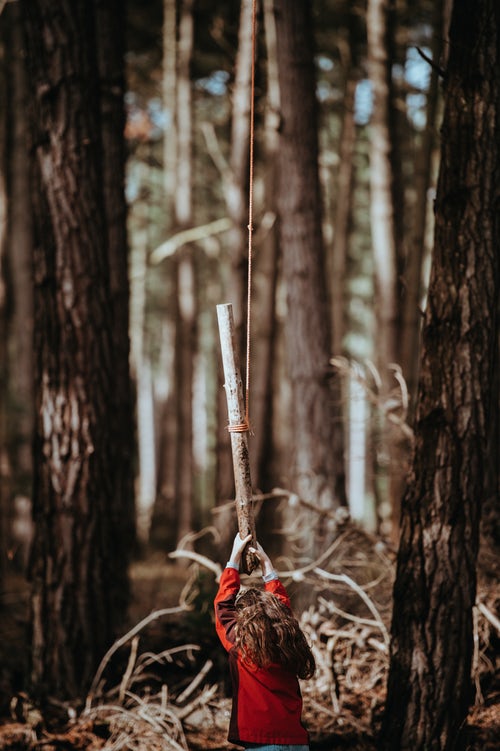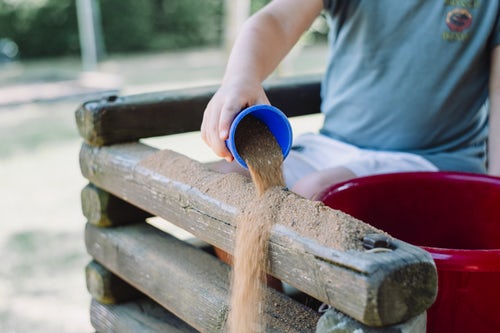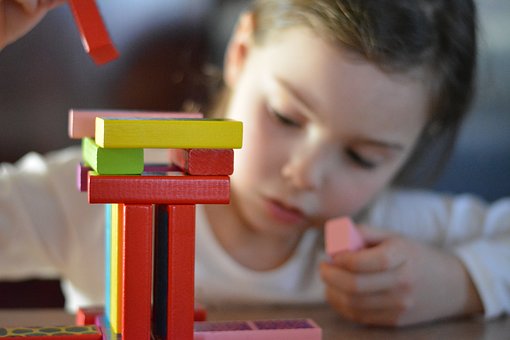
“A child’s greatest achievements are possible in play, achievements that tomorrow will become her basic level of real action and morality.” ~Lev Vygotsky
You probably know the old cliché about kids playing longer with the box a toy came in then the toy itself? It’s true. Child development experts in the UK asked 2,000 parents to compare their children’s interactions when they used devices, toys, and free play items like cardboard boxes. Almost twice as many parents said their children preferred playing with boxes than gadgets and 46 percent of children enjoyed playing with boxes instead of other toys and games.
Plain cardboard boxes are enticing because they’re free-form playthings. Beyond classic toys like wooden blocks, many best-selling toys don’t spark much open-ended fun. That’s because children play in less creative ways with toys based on popular movies or shows and play more passively with toys that make sounds, move, or otherwise perform. On the other hand, a wrapping paper tube can become nearly anything — a cane, magic wand, snake, lightsaber, boundary marker, whatever imagination chooses.
 The natural world is full of playthings. Sand, sticks, dirt, water, pinecones, leaves, logs, flowers, and rocks have inspired children’s imaginations for ages.
The natural world is full of playthings. Sand, sticks, dirt, water, pinecones, leaves, logs, flowers, and rocks have inspired children’s imaginations for ages.
So can pretty much anything kids are able to lift, drag, climb on, line up, dig with, join together, pour, dump out, take apart, swing around, push, or otherwise use as curiosity leads them. That is, as long as they have two key elements in their favor:
- children are given permission
- children are afforded the time.
Playground designers Vicki Stoecklin and Randy White write,
“The world once offered thousands of delights of free play to children. Children used to have access to the world at large, whether it was the sidewalks, streets, alleys, vacant lots and parks of the inner city or the fields, forests, streams and yards of suburbia and the rural countryside. Children could play, explore and interact with the natural world with little or no restriction or supervision.
Research on children’s preferences shows that if children had the design skills to do so, their creations would be completely different from the areas called playgrounds that most adults design for them. Outdoor spaces designed by children would not only be fully naturalized with plants, trees, flowers, water, dirt, sand, mud, animals and insects, but also would be rich with a wide variety of play opportunities of every imaginable type. If children could design their outdoor play spaces, they would be rich developmentally appropriate learning environments where children would want to stay all day.”

Back in 1971, architect Simon Nicholson wrote an article in Landscape Architect titled “How Not to Cheat Children: The Theory of Loose Parts.” He contended that most of us grow up, are educated, and live the rest of our lives in environments that stymie the imagination. He describes them as “static and impossible to play around with.” Instead of taking part in real planning and using real materials, “…children and adults and the community have been grossly cheated and the educational-cultural system makes sure that they hold the belief that this is ‘right.'”
For most of us the problem starts with tight restrictions in childhood.
- As kids, we’re not allowed to build or make things except within certain tight parameters (following instructions for a craft project is permitted, upending chairs to make an obstacle course is not).
- We can’t experiment with variables in unexpected ways (“Don’t make a mess!”).
- And we have limited experiences with exploration and discovery (“Stay on the playground, no climbing the trees.”). This inhibits creativity and inventiveness early on.

Sand belongs in the sandbox?
Mr. Nicholson’s theory of loose parts is this,
“In any environment, both the degree of inventiveness and creativity, and the possibility of discovery, are directly proportional to the number and kind of variables in it.” In other words, kids have nearly infinite ways to play when they have access to materials that can be used beyond a specific purpose.
Young children often use playthings as if they’re loose parts. A child combines a toy dinosaur, plastic teacup, dress-up scarf, and a few blocks into vivid and fully realized play on his own. Rules like keeping the tea cups with the tea set and putting away all the blocks before getting out another toy may keep the room neater but it also cuts down on much wider possibilities for play.
Kids (all of us, really) are more inventive and playful when our environments offer lots of variables. Open-ended materials let us transform simple materials into complex ideas. We play at what we’re most drawn to understand, right at the tantalizing edge of challenge, in ways unique to each of us. Recognizing this, more and more day care centers, museums, and playgrounds are starting to soften restrictions and offer loose parts for play.

Children’s Museum of Pittsburgh has a loose parts playground
At one day care center, children spend a large part of every day in a large fenced outdoor area, even when it’s raining. There’s no play structure with swings and slides, and few toys other than small wagons and plastic figures. There are, however, all sorts of loose parts for kids to use.
Two girl have made a bridge over a muddy area with a row of milk crates. They pound twigs with rocks until the wood crumbles into fibers, mix it with mud they scoop up with spoons, then arrange it on tree branch slices. A group of four-year-olds drag a few planks over some bicycle tires, running and jumping on the tippy boards in a game that seems to be about danger and rescue. Many kids are playing in little enclosures they’ve made from tarps hung over low tree branches or within a circle of logs. These child-made places are nearly empty some days, other days they’re brimming with activity. The most popular spot seems to be a large pile of dirt in a far corner, left there when a utility line had to be dug up and repaired. Some kids pour rivulets of water from the top of the pile, watching it snake down the uneven surface. Others put sticks in the dirt, arrange rocks on it, roll balls down it, and make ramps leading up to it. One little boy ran up and down the pile, but stopped when he saw he’d nearly stepped on another boy’s plastic figure. He crouched down next to him and they both buried, discovered, and reburied the toy a few times before flattening a path in the dirt with a measuring cup and letting the figure drive a measuring cup car on this de-facto road.
Here, children seem to require minimal involvement from their teachers. Instead they’re learning to play cooperatively — disputing and solving disputes, sorting and building, and mostly pretending. They’re also growing more physically adept while teaching themselves hands-on lessons about math and science. There’s no need for adults to keep loose parts organized, no need to step in and instruct, no need for a full day of pre-planned activities.

Similar to the center where Teacher Tom works. Visit his wise and instructive site for more.
Loose parts evoke more inventive play in older children as well. A two-year Australian study of primary school children found that adding objects like crates, buckets, pool noodles, and hay bales to their schoolyard caused sedentary behavior to drop by half while kids played with more enjoyment, imagination, and vigor.
Other studies have found that creativity and problem-solving soar when children use naturally occurring outdoor materials in their play, a contrast to adult-provided props so common in children’s lives. As researcher Dana Miller writes in an education journal article titled “The Seeds of Learning,”
“Our research presents compelling evidence that providing children with open-ended natural materials fosters imagination, creativity, and symbolic (abstract) thinking. When they are working with open-ended materials children get to decide what those materials will become, explore interesting ways to manipulate the materials, and how their use of those materials may change during a dramatic play scenario. Children get to search for just the right material or object to represent something in their minds, and through that use and the functions they assign to those materials, children display their brilliance.”

It’s easy to incorporate loose parts into children’s days. There’s no need to buy specialized loose parts and carefully sort them into containers after play. Along with some classic open-ended toys like blocks, construction sets, dress-up, and art supplies we can say yes to all sorts of other free-form materials. Many are probably already at hand.
And pay attention to temporary circumstances that crop up, giving kids in your family and in the neighborhood the opportunity to play around a tree that fell in a storm, a pile of dirt left after construction, or the rainfall that turned your neighborhood park into a puddle-rich haven for imagination.

Seeing what children will do if they have the freedom to create is always inspiring.
LikeLiked by 3 people
I think I must have had an ideal childhood. 5 acres of meadow, a stream running through it, endless possibilities for camps and structures to be built, a whole big shed filled with junk, a huge fallen tree, and when it was pouring with rain, books… I don’t remember toys, but the outdoors and the books are permanently engraved on my memory.
LikeLike
Growing up wild, I spent hours in trees, which makes me so happy! I will share this with my grandchild when I see her!
LikeLike
Great article! When we are visiting grandmother and grandfather in a small town, the children are very happy. They have at their disposal a huge field with a small stream and everything that they found in the barn 🙂 The children are always looking forward to this trip.
LikeLike
It sounds wonderful!
LikeLike